China has been a big tea-producing country since ancient times, and it is home to many world-famous teas. If you are a tea lover, our 13 days China tea tour is the one you can’t miss. During this tour, you can visit various attractions to taste famous teas. Mount Wuyi is known as the kingdom of tea, producing various kinds of tea. Our Wuyishan tea tour will take you to taste the most famous tea here, Dahongpao, which is not only delicious but also beneficial to your body. During this 13 days China tea tour, we will also go to the Longjing Tea Plantation in Hangzhou so that you can witness the tea-making process and taste the freshest Longjing Tea. Oolong tea is also a unique kind of tea in China, and you can taste this famous Chinese tea with a history of thousands of years in this Chinese Oolong tea tour. As long as you like drinking tea and tea culture, this 13 days China tea tour will surely make you satisfied. Come and join us to start a worthwhile tour!

Today, you will arrive in Hong Kong, and your guide will pick you up at the airport. You will be escorted to the hotel for a good rest. Hong Kong is located in southern China, with a total area of 1,106.66 square kilometers and a total population of 7,480,000. It is the most densely inhabited region in the world.
Option:
In the afternoon, you can go to Star Avenue, which is for honoring the outstanding people in the Hong Kong film industry. It is designed by simulating the Hollywood Walk of Fame. The names and palm prints of film practitioners, such as Jackie Chan, Chow Yun-fat and Sammo Hung, are inlaid on a special commemorative plaque. After visiting Star Avenue, you can go to Harbor City. The Harbor City is Hong Kong’s premier shopping destination, including more than 50 restaurants, 2 large movie theaters, and about 700 retail stores. Besides, there is also a small venue holding “Music in the City”. If you go there on Saturday or Sunday, you might happen to see a band playing music in the mall.
This morning, after breakfast, you will be driven to visit Wong Tai Sin Temple. The temple, built in 1945, is one of the most famous temples in Hong Kong. According to the legend, Wong Tai Sin, also called Immortal Chisong, is widely known for his excellent medical skills and kindness, and he is willing to grant whatever is requested. It is said Wong Tai Sin was originally named Huang Chuping, a native of Lanxi County, Jinhua City, Zhejiang Province. He was born in a poor family during the Eastern Jin Dynasty (317A.D.-420A.D.). At the age of 15, he met the Taoist priest, Shan Bu, while herding sheep on Chisong Mountain. Shan Bu thought Huang Chuping was extraordinary and then took him to learn Taoism for 40 years. Finally, Huang Chuping became an immortal and took Immortal Chisong as his nickname. Later, he visited many places, like Hong Kong, where he had stayed for many years and helped lots of people using his supernatural power. His benevolence won people’s respect. And the people courteously called his Wong Tai Sin(Wong is his surname in Cantonese, the dialect of Hong Kong and Tai Sin means great immortal.) and built the Wong Tai Sin Temple to worship his statue.
Then you will be escorted to visit the Victoria Peak. With an altitude of 554 meters, Victoria Peak is the highest peak in Hong Kong. We will arrange for you to take the Peak Tram to Victoria Peak, which is the first motorized public transport in Hong Kong. It was put into service on May 30, 1888. On the Victoria Peak, there is a building called Peak Tower. As a must-see attraction on Victoria Peak, it integrates sightseeing, entertainment and shopping. It is designed in the shape of a bowl by a famous French architect, Terry Farrel. And its image has been widely used on millions of postcards and photos. You can also stand on the 428-meter sightseeing platform- Sky Terrace 428 to have a panoramic view of the intoxicating scenery.
After coming down from Victoria Peak, you will go to Repulse Bay, which is located to the south of Victoria Peak. Repulse Bay, in the shape of a crescent, is hugged by mountains and sea. It is known as the “First Bay in the World” and recognized as the “Oriental Hawaii”. It is said that the name of the bay is derived from a British Royal warship that repulsed pirates many times in the bay.
Then you only need to walk along the beach of Repulse Bay for a few minutes to get to Zhenhai Tower Park, where you will see two 10-meter-high statues of Guanyin(Goddess of Mercy in Chinese mythology) and Tin Hau(Queen of Heaven). They are placed here to bless the seamen and swimmers.
Then you will be driven to the Stanley Market. Stanley Market is adjacent to the beautiful and clear Repulse Bay. Hong Kong locals are fond of spending their weekends here. Here you will see many western bars, which are very popular among foreigners. You can find diverse souvenirs of western and oriental features in the Stanley Market, including clothes, silk, decorations and artworks. You can buy your favorite specialties and enjoy the fun of bargaining. After strolling through the market, you can order a glass of beer and some dishes at a nearby bar to enjoy the sea breeze, listen to the waves, and feel the local town atmosphere. Then, you will be escorted back to the hotel to rest.
Option: In the evening, you can go to the Lan Kwai Fong, an area full of bars, restaurants, discos, and nightclubs. Lan Kwai Fong originated in the early 1970s. An Italian businessman opened an Italian clothing store and a restaurant here. Some Yuppies wanted to find a place to chat after their work, and this restaurant became their gathering place. Later, more and more various bars moved here and the Lan Kwai Fong has gradually become a popular bar street. There are different kinds of bars standing on the street, such as Dragon-I, Tazmania Ballroom as well as Schnurrbart German Pub and Restaurant. Dragon- I has been one of the busiest bars here. If you like jollification, you can choose the DJ area. If not, there is also a reserved room for you. In addition, there is also a restaurant. So you can enjoy a really pleasant time here. Tazmania Ballroom offers different dishes from various countries, and it has unique music and a really cool decoration inside. You can get an amazing experience here. Schnurrbart German Pub and Restaurant is a German bar. You can enjoy traditional German food, including Black Forest ham, smoked beef and sausage, with a bottle of aromatic German non-alcoholic wheat beer here. You will feel like you are in Munich!
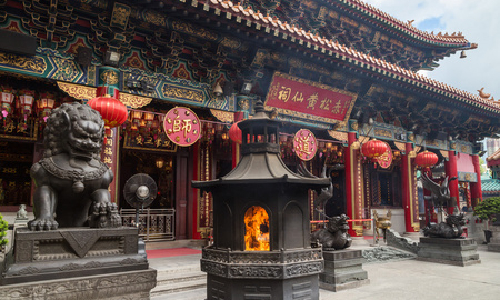
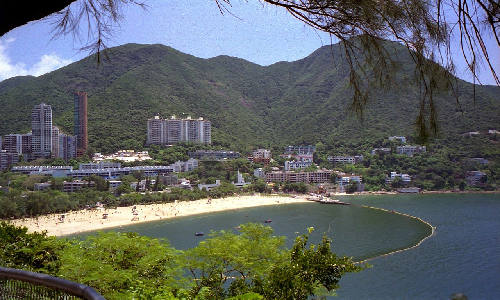
 Xiamen
Xiamen After breakfast, you will check out and go to the Lantau Island. Lantau Island is located in the southwest of Hong Kong. It is the largest island in Hong Kong, with an area of 147 square kilometers. And its main peak is 935 meters above sea level, which is the second-highest peak in Hong Kong. You will be driven to Ngong Ping and then take the Standard Cabin of the Ngong Ping 360 Cable Car to the Ngong Ping Village. The Ngong Ping 360 Cable Car is the longest double-cable car in Asia. As the moving of the cable car, you can overlook the Lantau Island, pay homage to the world’s largest outdoor sitting Buddha, and get a glimpse of the Hong Kong-Zhuhai-Macao Bridge, the world’s largest cross-sea bridge. The entire cable car route is 5.7 kilometers long and the journey takes about 20 minutes. For the Ngong Ping Village, it covers an area of 13,400 square meters and is full of Chinese cultural characteristics. There are also various high-tech entertainment facilities such as 360 VR experience halls and 360 dynamic cinemas, as well as diverse snack bars and gift shops.
Passing through the village, you will arrive at the Po Lin Monastery built in 1924. Po Lin Monastery is regarded as the first of the four major Zen Monasteries in Hong Kong (Zen, a Buddhist term, is a way of life for mankind to exercise thinking and develop wisdom). There are many buildings with Chinese characteristics in the monastery that are worth visiting, such as the Main Shrine Hall and the Hall of Heavenly Kings. In the main hall of this monastery, there are three Buddhist gods representing the past, present, and future lives. Furthermore, there is a monastic dinning hall inside the monastery, where visitors can take a rest and enjoy Buddhist cuisine if they need.
The Big Buddha, the world’s largest outdoor sitting Buddha, is located majestically on the Muyu Peak, opposite the Po Lin Monastery. The Big Buddha, built in 1993, is a statue of Sakyamuni, all made of bronze. The Buddha statue weighs about 250 tons and is 34 meters high, covering an area of about 6,567 square meters. The surface of the Big Buddha is coated with more than 4 kilograms of gold. Besides, its base imitates the design of the Temple of Heaven in Beijing, so it is also called “Big Buddha of the Temple of Heaven”. The base of the Big Buddha has three floors, and there is an exhibition hall where various Buddhist artworks, murals, calligraphy, etc. are displayed. Besides, inside the exhibition hall, there is a big bell with Buddha statues and scriptures carved on it. The bell is controlled by a computer and beats once every seven minutes, for a total of 108 times every day, which means helping people relieve 108 kinds of troubles in Buddhism. After visiting the Big Buddha, your mind and spirit may be refreshed.
Then, you will be sent to the airport and head to Xiamen by taking the estimated flight MF382 16:20/17:40. Your new guide will pick you up at the Xiamen airport and drive you to the hotel for a rest.
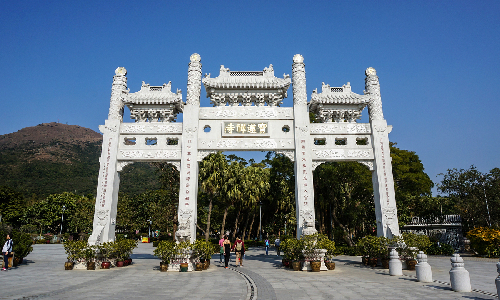
After breakfast, we will drive westward for about 3 hours to the Nanjing Tulou, 150 kilometers away from the center of Xiamen. Nanjing Tulou, also called Fujian Tulou, is a kind of building in the southern Fujian Province. It is home to most Hakka people (The Hakka is a Chinese ethnic group whose mother tongue is Hakka dialect). Nanjing Tulou was originated in the Song Dynasty (960-1279) and it got great development in the Ming Dynasty (1368-1644) and Qing Dynasty (1636-1912). Nanjing Tulou is built on the narrow flat ground of the mountain and made from raw soil, pebbles, glutinous rice, brown sugar and other materials. These materials will be mixed together first, then be stirred and tamped repeatedly to guarantee its viscidity and fastness. In 2008 it was included in the World Heritage List. Nanjing Tulou usually has three or five floors, which can accommodate 200 to 700 people, the first floor for the kitchen, the second floor for the warehouse and the third floor and above for the living room. In addition to the excellent buildings, there are also delicious Hakka foods made with homebred chicken, duck, fish, fresh bamboo shoots, wild vegetables etc.
Then you will go to the Tianluokeng Tulou Cluster, located in the western part of Nanjing County. It is mainly composed of a square building, three round buildings and an oval building. It is the settlement of the Hakka people surnamed Huang. It was first built in 1662, and the entire building process lasted 304 years. It was originally named Tianliaokeng Village but later it was renamed Tianluokeng Village because its terrain resembles a snail, furthermore the surrounding mountains are high and the middle terrain is low-lying which makes it look like a pit. Tianluokeng Tulou is built on the hillside, scattered high and low. If you look down from a high spot, it is like a blooming plum blossom dotting the earth. There is a legend about the name of the Tianluokeng Tulou Cluster. Huang Baisanlang, the ancestor of Tianluokeng people, was a diligent duck-breeding boy at the very beginning. One day, he was soaked by the rain suddenly when he was feeding the ducks in Tianluokeng. Huang Baisanlang wanted to find a place to take shelter from the rain, but he heard a cry for help from the pit. He rushed to the pit in the rain but saw nothing. Later, Huang Baisanlang found that the voice came from a big river snail in the pit. When Huang Baisanlang picked up the snail, the snail turned into a gorgeous girl, who said she was a Snail Girl. They fell in love at first sight. Later, Huang Baisanlang married the Snail Girl. The Snail Girl is smart and hard-working. She gave his husband a lot of help in his daily work. And under his wife’s help, Huang Baisanlang became a rich man from a duck-breeding boy. Many years later, in order to commemorate the merits of the Snail Girl, people named the small pit Tianluokeng (‘tianluo’ means the river snail and ‘keng’ means the pit in Chinese).
After lunch, you will visit the Yuchang Building, also located in Nanjing County. The Yuchang Building, built in 1368, was jointly funded by people from five families, Liu, Luo, Zhang, Tang, and Fan (five Chinese surnames). It is currently the oldest and largest round building in the world. There are 5 floors of 18.2 meters high, 54 rooms on each floor, 270 rooms in total, covering an area of 2,289 square meters. The first floor of the Yuchang Building is the kitchen; the second floor is the granary; the third and fourth floors are the living rooms; and the fifth floor is for storing coffins. The third and fourth floors of the building are supported by slanted wooden pillars. It seems that as long as a gust of wind blows, the building will fall. However, in more than 600 years, Yuchang Building has experienced numerous earthquakes and severe storms and it is still as safe as the beginning. Today, people of four surnames have moved out, and the residents in the Yuchang Building are all from the Liu family.
After appreciating the beauty of the Yuchang Building, you will head to the Taxia Village. The Taxia Village is a traditional Chinese village, located in the west of Shuyang Town, with an area of 5.68 square kilometers. It is home to the Hakka people. Buildings in Taxia Village are built along the river. Among them, there are two buildings located on both sides of the river, which resembles the shape of Tai Chi (Tai Chi is an important concept in Chinese cultural history, including the life attitude to the phenomenon and essence of everything. The shape of Tai Chi is a circle separated by an S-shaped curve in the middle). Therefore, the Taxia Village is known as the Tai Chi Water Village. Besides, the Taxia Village is not only rich in citrus, persimmon, plum and other fruits, but also has the first tea farm in Nanjing County, producing a great variety of tea, such as Anxi Tieguanyin, Maoxie, Meijian, and Oolong. The tea gardens here produce 125,000 kilograms of tea annually. Every year, Tieguanyin tea will be exported to Singapore. In Singapore, tea produced in Taxia Village enjoys an excellent reputation. You can buy some tea for your family or friends here.
Then you will be transferred to the Chengqi Building, about ten kilometers away from the Taxia Village. It was designed in the shape of a circle. The whole construction lasted for 81 years. It was said that during its construction, the weather was good. To thank Heaven for its help, the locals called the building “Tianzhu Building”(Tian means heaven and zhu means help). The diameter of the Chengqi Building is 73 meters, and the perimeter of its corridor is 229.34 meters. The building covers an area of 5,376.17 square meters with 4 stairs and 400 rooms. The Chengqi Building has the reputation of King of Round Building. In 1986, China’s Ministry of Posts and Telecommunications issued a set of stamps about Chinese residential houses. Among them, the building on the one-yuan note was the Chengqi Building. Besides, you can also experience the hospitality of the Hakka people, which is definitely an unforgettable memory. After finishing the visit to Chengqi Building, you will then be took back to your hotel in Xiamen.


After breakfast, the tour guide will take you to the port and take a ferry to Gulangyu Island. Gulangyu Island, covering an area of about 1.88 square kilometers, is located in the southwest of Xiamen Island. Gulangyu(Gu means drum; lang means wave; yu means island) is named for a special reef. In the southwest of the island, there is a reef more than two meters high with caves on the beach. Whenever the tide rises, the waves hit the reef and it sounds like beating a drum. Furthermore, the island has a pleasant climate and is known as a garden on the sea. Up to now, there are more than 1,000 buildings with oriental and western styles, including hospitals, schools, churches, and consulates, distributed on this island. Given this, the island can be called the “Museum of Architecture of All Nations”.
When it comes to Gulangyu, we have to mention the Sunlight Rock, commonly known as “Huang Rock”. It is said that in 1641, Zheng Chenggong, a famous Chinese military general in the late Ming Dynasty and early Qing Dynasty, came to Huang Rock. Seeing that the scenery here was as beautiful as that of the Sunlight Mountain in Japan, he took the word “Huang” apart and called the place “Sunlight Rock” (the Chinese character Huang is made up of Ri and Guang, representing sun and light respectively). The Sunlight Rock is located on the top of Longtou Mountain in the central south of Gulangyu Island. It is formed by two huge rocks, one vertical rock, and one horizontal rock. As the symbol of the Gulangyu Island, it has an altitude of 92.68 meters and is the highest peak on this island. Besides, there is a round platform on the top of the rock. Standing on it, you can have a panoramic view of Gulangyu Island.
On Gulangyu Island, another attraction which is worth mentioning is the Shuzhuang Garden. It was built in 1931 and covers an area of more than 3,000 square meters. It is located in the south of Gulangyu Island, facing the sea and leaning against Sunlight Rock. The garden was originally a private villa of a local gentry and was turned into a garden in 1955. The garden is divided into two parts, Canghai Garden and Bushan Garden. “Canghai” means hidden sea. When you come into this garden, you cannot see the sea at the beginning. But when you walk a certain distance and pass across the bamboo forest, you will see the amazing sea scenery. “Bushan” means making rockery. In this garden, you will see a variety of rockeries. Among them, the rockery called Twelve Holes with serial holes like a maze is a must-visit attraction. You can enjoy the unique beauty of this traditional Chinese garden decorated with small bridges, flowing water, strange mountains and rocks.
After enjoying the delicious lunch, we will head to the Nanputuo Temple, which is located at the foot of Wulao peak in the southeast of Xiamen. It covers an area of 258,000 square meters, including a building area of 21,279 square meters. It was built at the end of the Tang Dynasty (618-907) and was repaired in the Qing Dynasty. Nanputuo Temple is built on a mountain and faces the sea. On the central axis, there are main buildings such as the Hall of Heavenly Kings, the Great Buddha’s Hall, and the Depository of Buddhist Sutras. The Hall of Heavenly Kings is located in the front of the central axis, and the Great Buddha’s Hall is in the center of the whole temple. In addition to paying respects to the majestic Buddhist statues, you can also taste the famous specialty of Xiamen, Nanputuo vegetarian cake. The cake has a diversity of fillings, such as mung bean, coconut, pumpkin, taro, and green tea. Among them, the coconut and pumpkin cakes are highly recommended.
Then we are going to the last attraction for today, Wulao Peak, formerly known as Wulao Mountain (Wulao means five old people). Wulao Peak gets its name because it looks like five old people with white hair when it is surrounded by white clouds. The peak is located behind the Nanputuo temple. If you climb the steps from the back of the Depository of Buddhist Sutras in Nanputuo Temple, you will see three Chinese characters “Wulaofeng” (Wulao Peak) engraved on the hillside, and a huge Chinese character “Fo” (Buddha) engraved on a huge stone, which is more than 4 meters high and 3 meters wide. In the middle of Wulao Peak, there is a courtyard for retired monks and eminent monks to rest. Besides, you will see acacia richiis planted around the peak. Acacia richii is also called “Taiwan acacia richii”, because it comes from Taiwan. These trees show the deep connection between people on both sides of the Taiwan Strait. After appreciating the beauty of the Wulao Peak, we will return to the hotel.
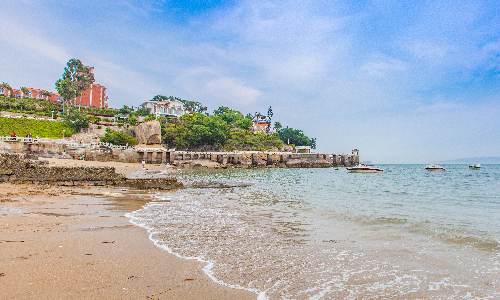
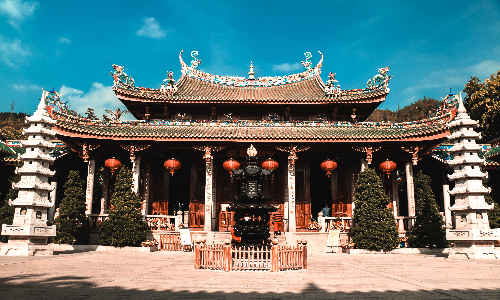
 Mount Wuyi
Mount Wuyi After breakfast, the tour guide will help you check out and the driver will take you to the Xiamen North Railway Station to take the estimated high-speed train G1754 08:14/11:23 to Nanping City.
The new guide and the driver will pick you up at the train station and then drive northwest(30KM) to Mount Wuyi. It might take you twenty-five minutes. Mount Wuyi locates at the junction of Jiangxi and Fujian provinces, with a length of 550 kilometers. Many peaks of Mount Wuyi are more than 1,000 meters above sea level. Mount Wuyi is an important tea-producing area. Dahongpao tea is the most prestigious tea in Mount Wuyi and is known as the “King of Tea”. If your relatives or friends like to drink tea, you can buy some Dahongpao tea for them. Dahongpao tea is a kind of Oolong tea, which is good for the people with poor digestion. The tour guide will take you to Tianyou Peak first (Tianyou means wandering in the sky), which is located in the center of the Mount Wuyi Scenic Area. It is called Tianyou Peak because when you stand on the Tianyou Peak, you will feel that you were wandering in a fairyland as the peak is surrounded by clouds. Then we will go to Yunwo (Yunwo means the home of clouds). There are more than ten caves of different sizes in Yunwo. In the morning and evening of the winter and spring, faint clouds and mists often emerge from the caves, wandering lightly between the peaks and rocks, sometimes gathering in a group, and sometimes drifting down slowly. Besides, there are many other attractions waiting for you to discover. Leaving the Mount Wuyi, your tour guide will take you back to the hotel


 Hangzhou
Hangzhou After breakfast, you will be taken to the Dahongpao Scenic Area. Here, you can feel the perfect combination of nature and artificiality from the towering mountains and lush tea gardens. The Dahongpao Scenic Area is named for producing the most famous Dahongpao tea in Mount Wuyi. One of the popular attractions here is the precious Dahongpao tea tree. There are 6 precious tea trees in the tea garden in total, which are located on the mountainside. There are stone weirs built to protect them. On the nearby rock wall, you will see three engraved Chinese characters, Dahongpao. Besides, there is a pavilion under the tea garden, where you can enjoy the beautiful scenery while tasting the famous tea.
The tour guide will then take you to the Shuilian Cave (shui refers to water and lian refers to curtain in Chinese). Shuilian Cave is the largest cave in Mount Wuyi scenic area, with an area of about 17 square kilometers. The two streams of clear spring that flow all the year in front of the cave, cascade down from the top of the 100-meter-high rock, like two hanging bead curtains. The Shuilian Cave is bright and can accommodate hundreds of people. There are stone tables and stools in the cave, which are convenient for visitors to rest.
After lunch, you will be transferred to the Yixiantian Scenic Area (Yixiantian refers to that the blue sky looks like a line). The Yixiantian Scenic Area is located in a secluded canyon at the southern end of Mount Wuyi. There is a huge boulder standing high into the sky inside. The top end of the boulder leans forward and covers three caves. Entering one cave, Fuxi Cave and look up, you will see a crevice at the top of the boulder, which looks like being split by a sharp axe. The crevice is less than one-third of a meter in width and more than 100 meters in length. The light leaks from the crevice and looks like a single line. This is the breathtaking Yixiantian. You will once again admire the supernatural craftsmanship of Nature.
After coming out of the Yixiantian Scenic Area, we will walk to the Tiger Roaring Rock, the well-known attraction in the south of Mount Wuyi. “The tiger’s roar” comes from a huge cave in the rock. It is said that when the wind passes through the cave, it sounds like a tiger’s roar, so it is called Tiger Roaring Rock. It is a place that can be compared with the steepness of Tianyou Peak in the whole Mount Wuyi Scenic Area, but after exploring it and seeing the beautiful scenery, you will feel it is worth visiting. Then you will be escorted to the railway station to take the estimated high-speed train G1668 18:37/21:04 to the Hangzhou East Railway station. Upon arrival, you will be transferred to a comfortable hotel for a good rest.

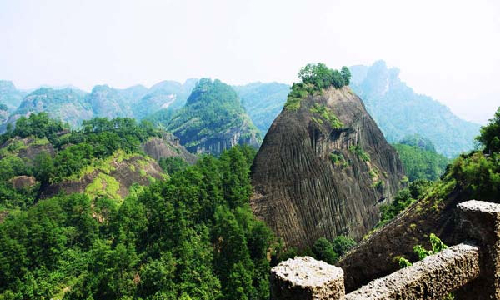
After breakfast, we will head to the West Lake. The West Lake is surrounded by mountains on three sides, covering an area of about 6.39 square kilometers. It was included in the World Heritage List in 2011. In the West Lake scenic area, you will find various kinds of trees, like willow, peach, pine, plum, bamboo. Besides, what you cannot miss are the famous attractions, such as Broken Bridge, Su Causeway, Leifeng Pagoda, etc. We will arrange for you to take a boat to appreciate the scenery of the West Lake. If you are lucky, you may see wild ducks, kingfishers, koi fish during your boat tour.
After lunch, you will visit the Feilai Peak (‘Feilai’ means ‘flying hither’), located on the west side of West Lake, about twenty minutes from West Lake by car. Feilai Peak is 168 meters high and is mainly composed of limestone. According to a legend, the Indian monk Huili came to Hangzhou more than 1600 years ago. He saw this peak and said in surprise, “It is totally the same with the peak of the Mount Lingjiu of Tianzhu (the ancient name of India). It seems that this peak flew hither from Tianzhu.” For Huili’s words, the peak here is called Feilai Peak by people. Due to the long-term erosion of groundwater, the Feilai Peak has formed many grotesque caves. There used to be 72 caves on the Feilai Peak. As time goes by, most of them have been buried. And the remaining caves are concentrated on the southeast side of Feilai Peak. Besides, in these caves and on the cliffs along the stream, there are more than 470 stone sculptures, of which 335 are relatively complete.
Then you will go to the Lingyin Temple. Lingyin Temple is an ancient Buddhist temple, facing Feilai Peak. It was first built in the year 326, covering an area of about 87,000 square meters. The founder of Lingyin Temple is monk Huili of West India. On the central axis of Lingyin Temple, there are the Hall of Heavenly Kings, the Main Shrine Hall, and the Medicine Buddha Hall. The seated statue of Maitreya at the entrance of the Hall of Heavenly Kings has a history of 200 years. The statue of Skanda, the Buddhist god who keeps evil away and guards the temple behind Maitreya, was created in the Southern Song Dynasty (1127-1279). The Main Shrine Hall, 33.6 meters high, is one of the best-preserved single-story temple buildings with double eaves in China. In the center of the hall, there is a gold-plated statue of Sakyamuni, 24.8 meters high. You can feel the traditional Chinese Buddhist culture here.
Afterward, we will take you to the Longjing Tea Plantation. Longjing tea has been famous since Song Dynasty, mainly produced near the West Lake. Longjing tea is known for its fragrance, green color, beautiful shape and good taste. There is also an interesting story about the West Lake Longjing tea. Emperor Qianlong of the Qing Dynasty once went to the West Lake to taste the fresh Longjing tea. Seeing the exquisite skill of the tea picking girls, Qianlong could not help learning to pick it. At this time, Qianlong’s entourage rushed to him and said that Empress Dowager was ill. Qianlong put the tea he had just picked into his sleeve and rushed back to Beijing. In fact, Empress Dowager didn’t have serious problems. She just had indigestion and missed her son(Emperor Qianlong) very much, which made her feel unwell. Seeing her son coming back, Empress Dowager felt better. Smelling the fragrance from her son, she asked him what it was. Qianlong took the tea leaves out to make tea for his mother. After the Empress Dowager drank it, she recovered soon. Emperor Qianlong was very happy, and he praised the 18 tea trees in front of Longjing Temple of West Lake as “royal tea tree”. Since then, Longjing tea has become the most famous tea in China. If you are lucky, you can see the tea-making process of professionals. You can also taste it and buy some for your friends and relatives. Then your guide will take you back to the hotel to have a good rest.

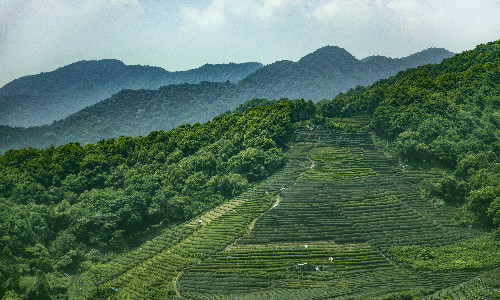
 Huangshan
Huangshan After breakfast, we will take the estimated high-speed train D5577 09:00/10:51 to Huangshan City. Upon arrival, we will drive southeast for 30 minutes to Tunxi Ancient Street. Tunxi Ancient Street is 1,272 meters long, with mountains in the north and waters in the south, including one straight street, three horizontal streets and eighteen alleys. If you walk through it, you will see buildings with Anhui’s traditional architectural style, which mainly uses brick, wood, and stone as the raw materials. Most of these buildings are of two-story structure, with shops in the lower story and houses in the upper story. When we come to Tunxi Ancient Street, we must mention the specialty here, Tunxi green tea. Because its production area has a warm climate, abundant rain and fertile soil, the tea has excellent quality. Tunxi green tea has a history of more than 1200 years. According to the research, drinking green tea can delay aging, prevent cardiovascular disease and help ease radiation injury. If you are interested in the green tea culture, Tunxi Ancient Street is one of the best places for you to learn the tea culture and taste the high-quality Tunxi green tea. Leaving the Tunxi Ancient Street, you will be escorted to the hotel for a rest.
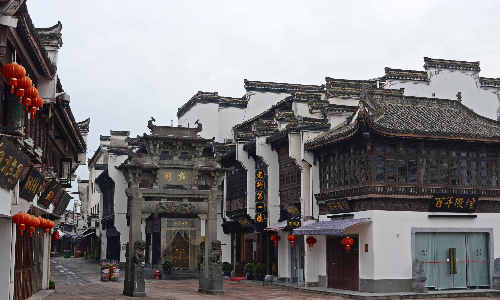
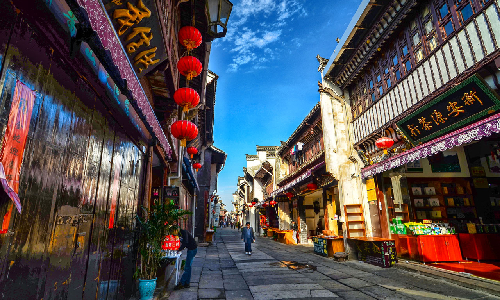
After breakfast, we will drive northwards to Mount Huang for nearly one hour(60KM). It is one of the top ten famous mountains in China. Furthermore, Mount Huang is one famous tea-producing area. There are more than 30 varieties of Huangshan(Mount Huang) Tea. Huangshan Maofeng tea is one of the top ten famous teas in China. It is a kind of green tea. When making Huangshan Maofeng tea, the water temperature should be about 80 ℃(176°F). After arriving at Mount Huang, we will go to the Yungu Temple first, which is located in the east of the Mount Huang Scenic Area, with an altitude of 890 meters. Apart from the surrounding peaks, there are also bamboos, pines, various-shaped rocks, yellow cedars and tea trees. Then you will take the Yungu cable car to admire the scenery on Mount Huang. We will first go to the Beginning-to-Believe Peak, which is 1,668 meters above sea level. On the peak, you can enjoy the scenery of the whole mountain.
Then we will go to the Dispelling Cloud Pavilion. The pavilion is 4 meters long, 5 meters wide, and 5 meters high, covering an area of 20 square meters. And in front of the pavilion, there is a platform, about 70 square meters, with stone railings and iron ropes. You can stand here to take a panoramic view of West Sea Grand Canyon, which is one of the 24 grand canyons in the Mount Huang Scenic Area. After appreciating the scenery here, we will walk southwards to the Flying-over Rock. The Flying-over Rock is 12 meters high and it is located on a flat rock. The contact surface between the two rocks is very small, and the rock above seems like flying over the rock below, so it is called Flying-over Rock. Then we will go to the Bright Summit. Located in the middle of Mount Huang, Bright Summit is one of the main peaks of Mount Huang, with an altitude of 1,841 meters. It is the second peak of Mount Huang. The top of it is flat and broad, so you can stand on it and take a panoramic view of the peaks. Then we will go to the hotel on the Bright Summit to watch the sunset. Your today’s journey will come to an end in the evening glow.
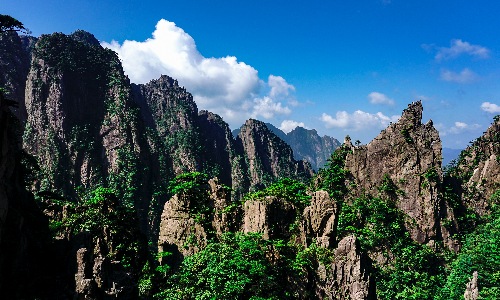

 Shanghai
Shanghai Today we are going to watch the sunrise on Mount Huang. We will walk to the Dawn Pavilion, located at the back of the Lion Peak on Mount Huang and facing the Beginning-to-Believe Peak. It is a great place to watch the sunrise. Then we will go to the Lion Peak. Standing on the Lion Peak, you can have a panoramic view of the Beginning-to-Believe peak and Bright Summit. When you come to Lion Peak, you can’t miss the Stone Monkey Watching the Sea. In the north of Lion Peak, there is a stone on the top of a peak, like a squatting monkey watching the sea of clouds. When the clouds dissipate, what the monkey is watching turns out to be the crop fields in the Taiping County(Taiping county is now called Huangshan District), so some local people also call it “Stone Monkey Watching Taiping”. After the visit to Lion Peak, we will walk to the cable car station and take the cable car down the mountain.
After having lunch, you will be sent to the railway station and set off for Shanghai by the estimated high-speed train G7308 13:02/15:47. The guide will pick you up and take you to the Bund. The Bund is located along the Huangpu River in Huangpu District, in the center of Shanghai, with a total length of about 1.5 km. When you walk along the Bund, you will find classic buildings with different styles, such as Gothic, Roman, Baroque, etc. on its west side. But when you look far into the distance on the east side, you will see some modern buildings, like the Oriental Pearl Tower, Jinmao Tower, etc. In addition to admiring these splendid buildings, you can also enjoy the charming Huangpu River scenery.
Then we will visit Nanjing Road, the first commercial street after the opening up of Shanghai. It starts from the Bund in the East, with a total length of 5.5 km, including Nanjing East Road and Nanjing West Road. Nanjing East Road is mainly a commercial and tourist area; Nanjing West Road is the most luxurious commercial area in Shanghai. It is a shopping paradise for visitors at home and abroad. There are many century-old shops here, such as Tong Ren Tang (a traditional Chinese Medicine shop), Shen Da Cheng (a pastry shop), and Zhang Xiao Quan (a scissor shop). You can buy some packaged pastries as the gifts for your relatives and friends. Then you will be escorted to the hotel to have a rest.

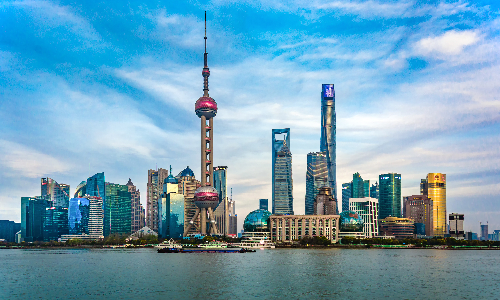
After breakfast, we will leave for Yu Garden (closed on Mondays). Yu Garden is a classical garden, covering more than 20,000 square meters. It was built in 1559 as a private garden. Now it is a popular attraction. It has a history of more than 400 years by now. There are pavilions, rockeries, ponds and sculptures and so on. Besides, there are more than 670 trees in the garden, and about half of them are evergreen, which means that whenever you visit Yu Garden, you will see vibrant plants. Furthermore, there are 27 trees more than 100 years old. In front of the Wanhua Building, an ancient ginkgo tree is more than 430 years old. It is 26 meters high with a 13.8-meter tree canopy diameter. Besides, in the Yu Garden, various activities are often held, such as flower shows, festival activities, calligraphy&painting exhibitions, and tea ceremony activities. If you are lucky, you may have a chance to participate in one of the activities.
After visiting Yu Garden, we will go to Shanghai Old Street. It was once an important venue for Shanghai’s foreign trade and small commodity trading, witnessing the economic and social development of Shanghai. When you walk into the Shanghai Old Street, you will find that the buildings from west to east have some differences in structure. The differences of these buildings implied China’s changes and development from the Ming and Qing Dynasties to the period of the Republic of China. Shanghai Old Street is a multi-functional street integrating tourism, shopping, entertainment and food. Here you can taste Shanghai Soup Dumplings, a special steamed dim-sum in Shanghai. It is mainly made of flour and pork. It is known for its small size, seasoned fillings(different types of meat, seafood, or vegetarian fillings), and flavorful soup. You are suggested to dip it in a mixture of Chinese black vinegar for a perfect taste.
Later we will visit Xintiandi Area, located in the center of Shanghai. It is a pedestrian street integrating foods, shopping, entertainment. In 2004, Xintiandi Area won Urban Land Institute (ULI) Award for Excellence. There are many old Shikumen buildings (Shikumen refers to a building composed of a pair of black wooden doors with arched stone door frame.), which can be high-end shops, restaurants or cafes. When you stroll in the Xintiandi Area, you may have a feeling of traveling back to the old Shanghai one hundred years ago. But when you enter the interior of each building, you will see the modern and fashionable decorations. It will be a wonderful experience.
After lunch, we will go to the Former French Concession. It used to be the largest French concession among the Four French Concessions in China. It was established in 1849. And it developed into the best and most advanced residential area in Shanghai in the 1920s. In this area, there are many old-style buildings, such as the Former Residence of Sun Yat-sen(the first leader of the Nationalist Party of China), the Former Residence of Ba Jin(a famous Chinese writer) and the former sites of government offices during the period of the Republic of China (1920s-1930s). In addition to the old-style buildings, some high-end and exquisite shopping malls are also interspersed among these old buildings.
After visiting the Former French Concession, we will go to Shanghai Tower, a skyscraper in Shanghai. Shanghai Tower has a total height of 632 meters with 127 floors above ground and 5 floors underground. Seeing from the top, the shape of Shanghai Tower is like a guitar pick. As the height rises, each layer twists nearly 1 degree. The whole tower is divided into different functional areas, such as entertainment area, office area, and hotel area, etc. What you cannot miss is to take the fastest elevator at a speed of 18 meters per second inside Shanghai Tower to the 118th floor. On this floor, there is a 360-degree transparent sightseeing platform, through which you can get a panoramic view of Shanghai. After visiting Shanghai Tower, you will be transferred back to the hotel.
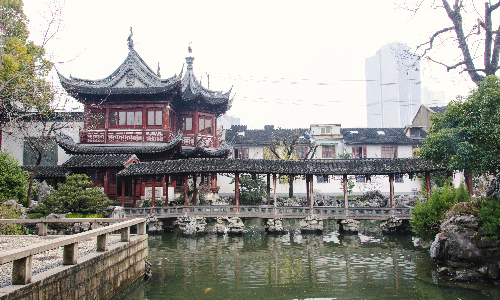
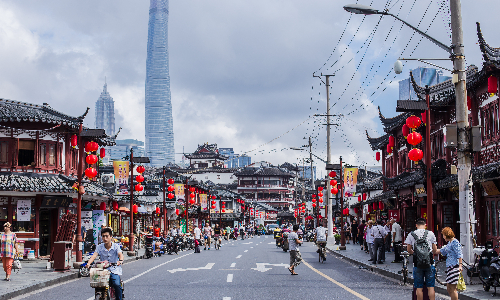
Today, your 13-day China tea tour will come to an end. After breakfast, our driver and guide will take you to the airport according to your flight schedule.
Editor: Xuelei Zhang
Proofreader: Yan Liu
| City | Five Star hotel list | Four Star hotel list |
|---|---|---|
| Hong Kong | Harbour Grand Kowloon | Harbour Plaza North Point Hotel |
| Xiamen | Jingmin Hotel Central Xiamen | Xiamen Huaqiao Hotel |
| Nanping | Ramada Plaza by Wyndham Nanping | Ramada Plaza by Wyndham Nanping |
| Hangzhou | Landison Plaza Hotel | Best Western Plus Meiyuan Hotel Hangzhou |
| Huangshan | Huangshan International Hotel | Huangshan International Hotel |
| Shanghai | Ocean Hotel Shanghai | Courtyard by Marriott Shanghai Central |
 |
![]() About your child or infant, please contact us for a discounted price.
About your child or infant, please contact us for a discounted price.



We started with a few days in Beijing & ended in Shanghai, from where we visited the Forbidden City and Great Wall. In between we visited Terra Cotta Warriors Museum, Panda Base, Shanghai Disneyland.

We had a wonderful holiday in China which will remain long in the memory. China is a breathtakingly beautiful country full of splendid temples and palaces, mountains and rivers, peaceful rural scenes and bustling shopping streets.
 QUICK ENQUIRY
QUICK ENQUIRY